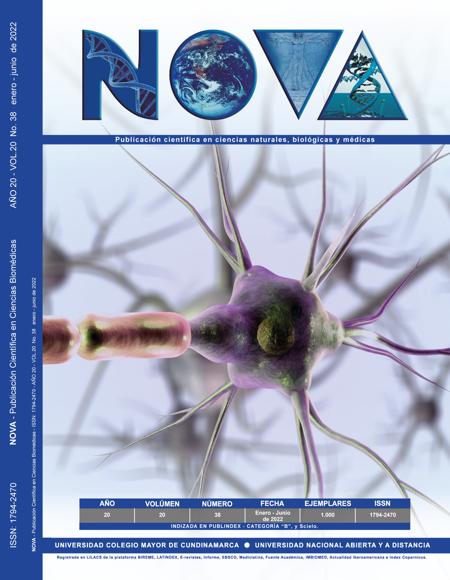Glycemic Excursions in Type 2 Diabetic Patients With Vildagliptin and Metformin Versus Vildagliptin and Glimepiride (GLOBE)
Excursiones de glucosa en pacientes con diabetes mellitus tipo 2 tratados con vildagliptina más metformina1 versus glimepirida más metformina –GLOBE–: Ensayo clínico aleatorizado
NOVA by http://www.unicolmayor.edu.co/publicaciones/index.php/nova is distributed under a license creative commons non comertial-atribution-withoutderive 4.0 international.
Furthermore, the authors keep their property intellectual rights over the articles.
Show authors biography
Objectives: Glycosylated hemoglobin could under-represent daily fluctuations in blood glucose. Multiple techniques have been proposed to study glycemic variability in order to better understand the metabolic control of the disease. The objective of this study is to compare the glycemic variability measured by MAGE and CONGA in the intervention and control group; In addition, compare the glycemic variability results obtained before and 12 weeks after the start of treatment in both groups.
Methods: Phase IV, randomized, multicenter, open-label clinical trial.Forty subjects were randomized to receive vildagliptine plus metformin1 or glimepiride plus metformin for a period of 12 weeks. Continuous blood glucose monitoring was performed before and after the treatment period using iPro2 devices. The results of glycemic variability measured by MAGE, CONGA and DET were compared. The safety and tolerability profile of the interventions was compared.
Results: The use of GalvusMet®️ or glimepiride plus metformin for 12 weeks in diabetic patients with poor glycemic control was associated with a statistically significant reduction in glycemic variability (Wilcoxon p-value <0.005) and HbA1c (Wilcoxon p-value <0.005) in both groups; however, insufficient evidence was found to determine the superiority of the treatments. No differences were detected in the safety or tolerability profile of the drugs.The results of the study suggest that the evaluated treatment regimens are equivalent. Additional studies are required to determine the clinical significance of the results.
Article visits 506 | PDF visits 332
Downloads
- Barceló A, Rajpathak S. Incidence and prevalence of diabetes mellitus in the Americas. Rev Panam Salud Pública. 2001;10(5):300-8. doi: 10.1590/s1020-49892001001100002.
- https://doi.org/10.1590/S1020-49892001001100002
- Wild S, Roglic G, Green A, Sicree R, King H. Global prevalence of diabetes: estimates for the year 2000 and projections for 2030. Diabetes Care. 2004 May;27(5):1047-53. doi:10.2337/diacare.27.5.1047
- https://doi.org/10.2337/diacare.27.5.1047
- Chawla A, Chawla R, Jaggi S. Microvasular and macrovascular complications in diabetes mellitus: Distinct or continuum?. Indian J Endocrinol Metab. 2016;20(4):546-551. doi:10.4103/2230-8210.183480
- https://doi.org/10.4103/2230-8210.183480
- Intensive blood-glucose control with sulphonylureas or insulin compared with conventional treatment and risk of complications in patients with type 2 diabetes (UKPDS 33). UK Prospective Diabetes Study (UKPDS) Group. Lancet (London, England). 1998 Sep;352(9131):837-53.
- https://doi.org/10.1016/S0140-6736(98)07019-6
- Diabetes Control and Complications Trial (DCCT): results of feasibility study. The DCCT Research Group. Diabetes Care. 1987;10(1):1-19. doi:10.2337/diacare.10.1.1
- https://doi.org/10.2337/diacare.10.1.1
- The ADVANCE Collaborative Group. Intensive Blood Glucose Control and Vascular Outcomes in Patients with Type 2 Diabetes. N Engl J Med. 2008;358(24):2560-72. doi: 10.1056/NEJMoa0802987
- https://doi.org/10.1056/NEJMoa0802987
- The Action to Control Cardiovascular Risk in Diabetes Study Group. Effects of Intensive Glucose Lowering in Type 2 Diabetes. N Engl J Med. 2008;358(24):2545-59. doi: 10.1056/NEJMoa0802743
- https://doi.org/10.1056/NEJMoa0802743
- Huang IC, Wang PW, Liu RT, Tung SC, Chen JF, Kuo MC, et al. The influence of self-monitoring blood glucose frequency on the oscillation of hemoglobin A1c and chronic complications. Chang Gung Med J. 2012;35(1):46-53. doi: 10.4103/2319-4170.106167.
- https://doi.org/10.4103/2319-4170.106167
- Kilpatrick ES. Arguments for and against the Role of Glucose Variability in the Development of Diabetes Complications. J Diabetes Sci Technol J Diabetes Sci Technol. 2009;3(4):649-55. doi: 10.1177/193229680900300405
- https://doi.org/10.1177/193229680900300405
- Monnier L, Colette C, Owens DR. Glycemic variability: the third component of the dysglycemia in diabetes. Is it important? How to measure it? J Diabetes Sci Technol. 2008;2(6):1094-100. doi: 10.1177/193229680800200618
- https://doi.org/10.1177/193229680800200618
- Brownlee M. The pathobiology of diabetic complications: A unifying mechanism. Diabetes. 2005;54(6):1615-25. doi: 10.2337/diabetes.54.6.1615
- https://doi.org/10.2337/diabetes.54.6.1615
- Monnier L, Mas E, Ginet C, Michel F, Villon L, Cristol J-P, et al. Activation of oxidative stress by acute glucose fluctuations compared with sustained chronic hyperglycemia in patients with type 2 diabetes. JAMA. 2006;295(14):1681-7. 10.1001/jama.295.14.1681.
- https://doi.org/10.1001/jama.295.14.1681
- Chase JG, Shaw G, Le Compte A, Lonergan T, Willacy M, Wong X-W, et al. Implementation and evaluation of the SPRINT protocol for tight glycaemic control in critically ill patients: a clinical practice change. Crit Care. 2008;12(2):R49. doi:10.1186/cc6868
- https://doi.org/10.1186/cc6868
- Wentholt IME, Kulik W, Michels RPJ, Hoekstra JBL, DeVries JH. Glucose fluctuations and activation of oxidative stress in patients with type 1 diabetes. Diabetologia. 2008;51(1):183-90. doi: 10.1007/s00125-007-0842-6
- https://doi.org/10.1007/s00125-007-0842-6
- McCarter RJ, Hempe JM, Chalew SA. Mean blood glucose and biological variation have greater influence on HbA1c levels than glucose instability: an analysis of data from the Diabetes Control and Complications Trial. Diabetes Care. 2006;29(2):352-5. doi: 10.2337/diacare.29.02.06.dc05-1594
- https://doi.org/10.2337/diacare.29.02.06.dc05-1594
- Blaak EE, Antoine JM, Benton D, Bj??rck I, Bozzetto L, Brouns F, et al. Impact of postprandial glycaemia on health and prevention of disease. Obes Rev. 2012;13(10):923-84. doi: 10.1111/j.1467-789X.2012.01011.x
- https://doi.org/10.1111/j.1467-789X.2012.01011.x
- Service FJ, Molnar GD, Rosevear JW, Ackerman E, Gatewood LC, Taylor WF. Mean Amplitude of Glycemic Excursions, a Measure of Diabetic Instability. Diabetes. 1970 Sep 1;19(9):644 LP-655. doi: 10.2337/diab.19.9.644
- https://doi.org/10.2337/diab.19.9.644
- Hill NR, Oliver NS, Choudhary P, Levy JC, Hindmarsh P, Matthews DR. Normal reference range for mean tissue glucose and glycemic variability derived from continuous glucose monitoring for subjects without diabetes in different ethnic groups. Diabetes Technol Ther. 2011;13(9):921-8. doi: 10.1089/dia.2010.0247
- https://doi.org/10.1089/dia.2010.0247
- Rodbard D. Glycemic variability: measurement and utility in clinical medicine and research--one viewpoint. Diabetes technology & therapeutics. United States. 2011;13:1077-80. doi:10.1089/dia.2011.0104
- https://doi.org/10.1089/dia.2011.0104
- Suh S, Kim JH. Glycemic Variability : How Do We Measure It and Why Is It Important ?. Diabetes Metab J. 2015; 39(4): 273-282. doi: 10.4093/dmj.2015.39.4.273
- https://doi.org/10.4093/dmj.2015.39.4.273
- Hill NR, Oliver NS, Choudhary P, Levy JC, Hindmarsh P, Matthews DR. Normal reference range for mean tissue glucose and glycemic variability derived from continuous glucose monitoring for subjects without diabetes in different ethnic groups. Diabetes Technol Ther. 2011;13(9):921-8. doi: 10.1089/dia.2010.0247
- https://doi.org/10.1089/dia.2010.0247






